A washer is a device used for cleaning items, effectively removing stains and impurities from their surfaces. Depending on their application scenarios and the nature of the items being cleaned, washers can be classified into various types such as household dishwashers, industrial washers, and vehicle washers. Each type of washer has its specific design and cleaning principles, but their core purpose is to provide efficient cleaning results.
Household Dishwashers
Household dishwashers are primarily used for cleaning dishes, kitchen utensils, etc., by spraying water and detergent to remove grease and food residues. Modern household dishwashers usually feature automated control functions, enabling the selection of appropriate cleaning programs based on the materials of the dishes and the degree of soiling.
Industrial Washers
Industrial washers find application in a wider range of settings such as factories, hospitals, laboratories, etc., where they are used to clean large equipment, clothing, or items made of special materials. These washers typically possess stronger cleaning capabilities and higher efficiency.
Vehicle Washers
Vehicle washers are specifically designed for cleaning vehicles, providing quick and thorough cleaning of entire vehicles, thereby saving labor and time.
Working Principles of Washers
The working principles of washers can generally be categorized into two main types: physical cleaning and chemical cleaning. Physical cleaning primarily involves the use of water flow to dislodge stains from the surface of objects, while chemical cleaning involves the use of detergents to dissolve stains, followed by rinsing with water flow.
Physical Cleaning
In physical cleaning, the pressure and angle of the water flow are crucial factors that need precise control via nozzles to ensure effective cleaning. For example, in household dishwashers, water flows through spray arms to exert pressure on the dishes, removing stains through the force of the water.
Chemical Cleaning
Chemical cleaning involves the types and concentrations of detergents used; appropriate detergents can effectively remove stains without damaging the material of the items being cleaned. In some specialized washers, such as ultrasonic dishwashers, high-frequency vibrations are utilized to accelerate the breakdown and removal of stains.
Use and Maintenance of Washers
Proper use and maintenance of washers are crucial for extending their lifespan and ensuring cleaning effectiveness. Users should follow the instructions correctly, regularly clean and disinfect the washers to prevent bacterial growth and odors. Additionally, attention should be paid to keeping the storage environment dry and ventilated to prevent machine damage.
FAQs
Q1: How to choose the appropriate cleaning program for washers?
A1: Washers typically offer multiple program options for different cleaning needs. Users should select the appropriate program based on their actual requirements and the materials of the items being cleaned.
Q2: How to perform self-cleaning for washers?
A2: Some high-end washers come with self-cleaning functions, allowing internal cleaning through built-in cleaning modes to maintain the cleanliness and hygiene of the washers themselves.
Q3: What to do if problems occur during the cleaning process with washers?
A3: If problems such as blockages, abnormal noise, or unsatisfactory cleaning results occur during the cleaning process, users should promptly inspect and repair the washers. They can refer to the user manual or contact professional technicians for assistance.
Conclusion
Washers are versatile cleaning tools widely used in household, industrial, and commercial sectors. Regardless of the type of washer, the basic principle is to achieve cleaning through physical or chemical means. Proper use and maintenance are not only related to cleaning effectiveness but also serve as crucial guarantees for extending the equipment’s lifespan.

